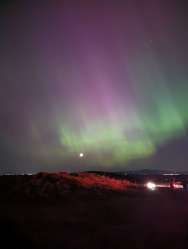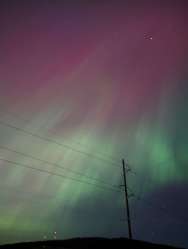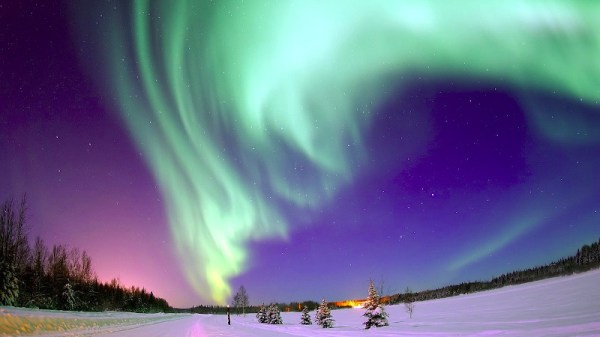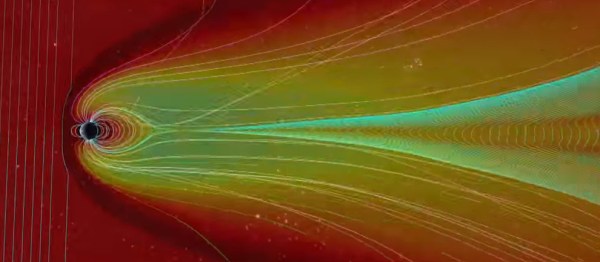It’s amazing how fragile our digital lives can be, and how quickly they can fall to pieces. Case in point: the digital dilemma that Paris Buttfield-Addison found himself in last week, which denied him access to 20 years of photographs, messages, documents, and general access to the Apple ecosystem. According to Paris, the whole thing started when he tried to redeem a $500 Apple gift card in exchange for 6 TB of iCloud storage. The gift card purchase didn’t go through, and shortly thereafter, the account was locked, effectively bricking his $30,000 collection of iGadgets and rendering his massive trove of iCloud data inaccessible. Decades of loyalty to the Apple ecosystem, gone in a heartbeat.
solar storm8 Articles
Hackaday Links: June 2, 2024
So you say you missed the Great Solar Storm of 2024 along with its attendant aurora? We feel you on that; the light pollution here was too much for decent viewing, and it had been too long a day to make a drive into the deep dark of the countryside survivable. But fear not — the sunspot that raised all the ruckus back at the beginning of May has survived the trip across the far side of the sun and will reappear in early June, mostly intact and ready for business. At least sunspot AR3664 seems like it’s still a force to be reckoned with, having cooked off an X-class flare last Tuesday just as it was coming around from the other side of the Sun. Whether 3664 will be able to stir up another G5 geomagnetic storm remains to be seen, but since it fired off an X-12 flare while it was around the backside, you never know. Your best bet to stay informed in these trying times is the indispensable Dr. Tamitha Skov.
Hackaday Links: May 19, 2024
If there was one question we heard most often this week, it was “Did you see it?” With “it” referring to the stunning display of aurora borealis — and australis, we assume — on and off for several days. The major outburst here in North America was actually late last week, with aurora extending as far south as Puerto Rico on the night of the tenth. We here in North Idaho were well-situated for prime viewing, but alas, light pollution made things a bit tame without a short drive from the city lights. Totally worth it:
Hat tip to Tom Maloney for the pics. That last one is very reminiscent of what we saw back in 1989 with the geomagnetic storm that knocked Québec’s grid offline, except then the colors were shifted much more toward the red end of the spectrum back then.
Hackaday Links: October 30, 2022
Sad news for kids and adults alike as Lego announces the end of the Mindstorms line. The much-wish-listed line of robotics construction toys will be discontinued by the end of this year, nearly a quarter-century after its 1998 introduction, while support for the mobile apps will continue for another couple of years. It’s probably fair to say that Mindstorms launched an entire generation of engineering careers, as it provided a way to quickly prototype ideas that would have been difficult to realize without the snap-fit parts and easily programmed controllers. For our money, that ability to rapidly move from idea to working model was perhaps the strongest argument for using Mindstorms, since it prevented that loss of momentum that so often kills projects. That was before the maker movement, though, and now that servos and microcontrollers are only an Amazon order away and custom plastic structural elements can pop off a 3D printer in a couple of hours, we can see how Mindstorms might no longer be profitable. So maybe it’s a good day to drag out the Mindstorms, or even just that big box of Lego parts, and just sit on the carpet and make something.
Hackaday Links: July 3, 2022
Looks like we might have been a bit premature in our dismissal last week of the Sun’s potential for throwing a temper tantrum, as that’s exactly what happened when a G1 geomagnetic storm hit the planet early last week. To be fair, the storm was very minor — aurora visible down to the latitude of Calgary isn’t terribly unusual — but the odd thing about this storm was that it sort of snuck up on us. Solar scientists first thought it was a coronal mass ejection (CME), possibly related to the “monster sunspot” that had rapidly tripled in size and was being hyped up as some kind of planet killer. But it appears this sneak attack came from another, less-studied phenomenon, a co-rotating interaction region, or CIR. These sound a bit like eddy currents in the solar wind, which can bunch up plasma that can suddenly burst forth from the sun, all without showing the usually telltale sunspots.
Then again, even people who study the Sun for a living don’t always seem to agree on what’s going on up there. Back at the beginning of Solar Cycle 25, NASA and NOAA, the National Oceanic and Atmospheric Administration, were calling for a relatively weak showing during our star’s eleven-year cycle, as recorded by the number of sunspots observed. But another model, developed by heliophysicists at the U.S. National Center for Atmospheric Research, predicted that Solar Cycle 25 could be among the strongest ever recorded. And so far, it looks like the latter group might be right. Where the NASA/NOAA model called for 37 sunspots in May of 2022, for example, the Sun actually threw up 97 — much more in line with what the NCAR model predicted. If the trend holds, the peak of the eleven-year cycle in April of 2025 might see over 200 sunspots a month.
So, good news and bad news from the cryptocurrency world lately. The bad news is that cryptocurrency markets are crashing, with the flagship Bitcoin falling from its high of around $67,000 down to $20,000 or so, and looking like it might fall even further. But the good news is that’s put a bit of a crimp in the demand for NVIDIA graphics cards, as the economics of turning electricity into hashes starts to look a little less attractive. So if you’re trying to upgrade your gaming rig, that means there’ll soon be a glut of GPUs, right? Not so fast, maybe: at least one analyst has a different view, based mainly on the distribution of AMD and NVIDIA GPU chips in the market as well as how much revenue they each draw from crypto rather than from traditional uses of the chips. It’s important mainly for investors, so it doesn’t really matter to you if you’re just looking for a graphics card on the cheap.
Speaking of businesses, things are not looking too good for MakerGear. According to a banner announcement on their website, the supplier of 3D printers, parts, and accessories is scaling back operations, to the point where everything is being sold on an “as-is” basis with no returns. In a long post on “The Future of MakerGear,” founder and CEO Rick Pollack says the problem basically boils down to supply chain and COVID issues — they can’t get the parts they need to make printers. And so the company is looking for a buyer. We find this sad but understandable, and wish Rick and everyone at MakerGear the best of luck as they try to keep the lights on.
And finally, if there’s one thing Elon Musk is good at, it’s keeping his many businesses in the public eye. And so it is this week with SpaceX, which is recruiting Starlink customers to write nasty-grams to the Federal Communications Commission regarding Dish Network’s plan to gobble up a bunch of spectrum in the 12-GHz band for their 5G expansion plans. The 3,000 or so newly minted experts on spectrum allocation wrote to tell FCC commissioners how much Dish sucks, and how much they love and depend on Starlink. It looks like they may have a point — Starlink uses the lowest part of the Ku band (12 GHz – 18 GHz) for data downlinks to user terminals, along with big chunks of about half a dozen other bands. It’ll be interesting to watch this one play out.
Radio Amateurs & Skywatchers Rejoice, Sat Operators Worry: Solar Storm Incoming
How do you look back over your life and divide it up? Maybe by decades, cultural moments, or geopolitical events. For radio amateurs with older callsigns there’s a temptation to do so by solar cycles, as the roughly 11-year period of the Sun’s activity had a huge effect on radio propagation through the charge it creates in the upper atmosphere. We’re now in solar cycle 25, numbered since the 18th century when the science of solar observation began, and as never before we’re surrounded by information from experts such as [Dr. Tamitha Skov], the so-called [Space Weather Woman]. When she says something is on the way we listen, so a recent Tweet predicting a direct hit from a solar storm with a good probability of auroras in lower latitudes is very much worth sharing.
We must extend our commiserations to readers in equatorial climes and ever through the lower half of the USA, southern Europe, the Middle East, India, Japan, and China. You won’t see the aurora we’ll catch in Europe along with our friends in New Zealand, Canada, Russia, and northern USA. But even then to those of us at moderate latitudes an aurora is a pretty rare event, so we’re hoping for clear skies on the 2nd of February and would advise you to look out too if you’re in the likely zone even if they won’t be quite as impressive as those in our header picture. Meanwhile radio amateurs everywhere don’t have to see pretty lights in the sky to reap the benefits in terms of propagation, so happy DX hunting! The Tweet is embedded below the break, so you can play the timeline for yourselves.
Continue reading “Radio Amateurs & Skywatchers Rejoice, Sat Operators Worry: Solar Storm Incoming”
The 1859 Carrington Event
Like many Victorian gentlemen of means, Richard Carrington did not need to sully himself with labor; instead, he turned his energies to the study of natural philosophy. It was the field of astronomy to which Carrington would apply himself, but unlike other gentlemen of similar inclination, he began his studies not as the sun set, but as it rose. Our star held great interest for Carrington, and what he saw on its face the morning of September 1, 1859, would astonish him. On that morning, as he sketched an unusual cluster of sunspots, the area erupted in a bright flash as an unfathomable amount of energy stored in the twisted ropes of the Sun’s magnetic field was released, propelling billions of tons of star-stuff on a collision course with Earth.
Carrington had witnessed a solar flare, and the consequent coronal mass ejection that would hit Earth just 17 hours later would result in a geomagnetic storm of such strength that it would be worldwide news the next day, and would bear his name into the future. The Carrington Event of 1859 was a glimpse of what our star is capable of under the right circumstances, the implications of which are sobering indeed given the web of delicate connections we’ve woven around and above the planet.
















